Saving New Permanent Teeth After Injury
Can Root Canal Treatment Help Save An Injured Tooth That's Still Growing?

Tooth injuries are common, particularly in late childhood. When a permanent tooth is injured, or damaged by decay, it is always best to try to save it rather than remove it. This is especially true in the case of older children and young adults, who need a full set of teeth to help guide the continuing growth and development of their jaws and bite. Because their jawbone structure is still developing, they are also not physically ready to receive a permanent artificial replacement tooth should a natural tooth be lost. Yet this age group is also the most prone to dental injuries, and saving an immature permanent tooth can present a complex — but definitely not hopeless — situation. What can be done?
Pulp Fact — Not Fiction
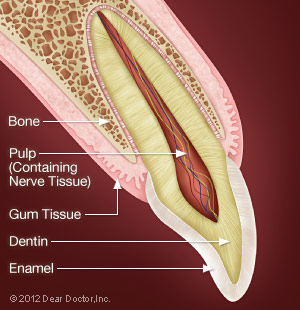 |
| A cross section of a fully formed, healthy front tooth, showing the pulp (nerve tissue) in relation to the surrounding tooth structures. |
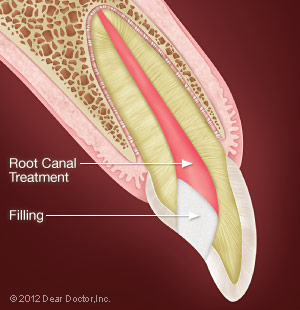 |
| A successful root canal procedure is necessary to save a tooth once the nerve tissue dies as a result of tooth decay or trauma. Access to the root canal space is gained by making a small opening from the tongue side of a front tooth. |
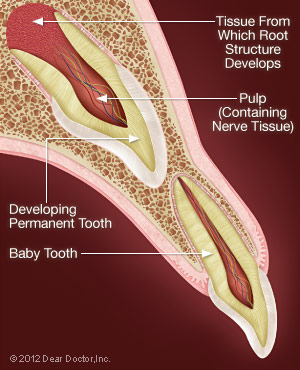 |
| As the permanent tooth develops, it starts to erupt towards the baby tooth. |
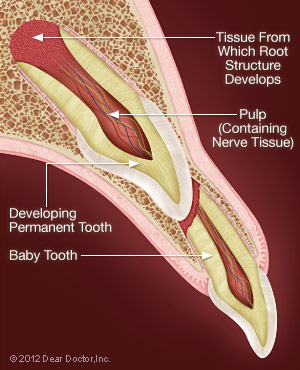 |
| As the root of the permanent tooth develops and erupts, the roots of the baby tooth resorb (melt away), causing it to loosen and eventually shed. |
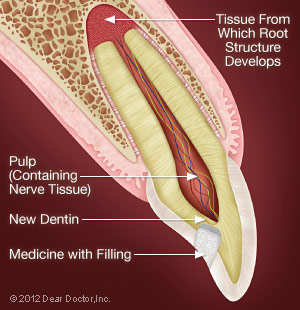 |
| An “indirect pulp cap” technique allows removal of infected, decayed dentin and the application of specialized bio-compatible medicines that promote healing of the pulp and completion of root development. |
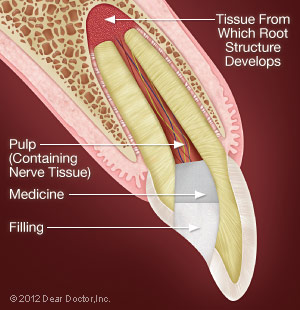 |
| When decay begins to infect the pulp, a “pulpotomy” is used to remove the infected portion while preserving the remaining healthy tissue to promote continued root development. |
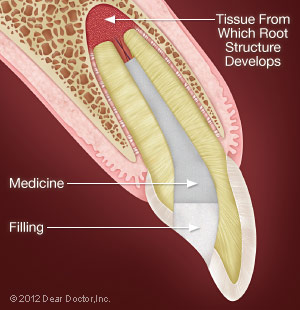 |
| Deeper “pulpotomy” — removal of most but not all pulp tissue when it has been more severely damaged — can still allow for completion of healthy root formation. |
 |
| When the pulp tissue is no longer salvageable due to infection in an immature root, disinfection and sterilization of the root canal and treatment with specialized bio-materials promote healing of the surrounding tissues and bone. |
First, it's important to understand why this age group presents particular challenges not seen in adults. When an adult injures a fully formed tooth, it can often be saved with a routine root canal filling procedure, in which the damaged, infected or dead tissue of the pulp, which is located deep inside the tooth, is removed and the canals which housed it are sealed. Healthy pulp tissues are vital, containing connective tissue, blood vessels and nerves that enable the tooth to grow and perceive sensation. But the pulp can also become infected and actually die when a tooth is damaged by trauma or decay.
This can be very problematic not only for completion of proper root development, but everything else that it affects: proper bite development, jawbone and facial growth, as well as the more usual elements associated with teeth — chewing, speech and aesthetics. And it's difficult, if not impossible, to replace teeth when the system in which they're developing is itself growing and changing so rapidly. So there are many reasons to save damaged or traumatized immature permanent teeth, at least until the individual has reached maturity when, if necessary, the tooth can be replaced within the framework of a healthy and functional bite.
In the case of an adult with fully formed teeth, pulp death is not as bad as it sounds. A full-grown tooth does not need its pulp, which can be removed if diseased, and the cavity (or “canal”) disinfected and sealed. Baby teeth, which will eventually be lost, can also be saved until their natural loss, but present their own special treatment circumstances. (See “Root Canal Treatment for Children's Teeth”)
The development of a tooth starts with an enamel cap known as the crown (the part you see in your mouth). Enamel is the hardest and most durable substance produced in nature. Inside the enamel cap, the body of the tooth forms out of a bone-like substance called dentin. A permanent tooth that's still developing needs to maintain its own vital tissue because it is the living pulp within that will generate the dentin of the roots of the tooth. Just as coral produces the hard calcium structure around it to protect its soft inner living parts, so too does the pulp tissue produce the dentin body and roots of a tooth — and this is impossible to accomplish without tooth pulp. In fact, the developing roots help guide the crowns of teeth into position during the eruption process.
After the roots are fully formed, the pulp continues to deposit dentin throughout life, so that the chamber in which it lives gets smaller and smaller. If the pulp dies prematurely, root formation in the young tooth cannot be completed; thus the tooth cannot respond to any sensation. In due course a “non-vital” or “dead” tooth becomes brittle and darker due to dehydration and blood stagnation, and thus more prone to fracture, particularly if root formation is incomplete. So it's important to try to rescue the pulp, which in turn will save the tooth.
There are specialized techniques for doing just that — painlessly, effectively and relatively inexpensively. In this article, the second part of a series on root canal procedures, we will explain treatment of injury to immature permanent teeth.
Pathways To The Pulp
Today, even when the pulp is damaged, its vitality can be maintained with a variety of endodontic (“endo” – inside; “dont” – tooth) techniques. What's more, stem cell research is leading to the ability to completely replace dead pulp with new tissue in immature permanent teeth. Thus all pathways are leading to the salvation of a healthy tooth with a vital pulp.
The first step in all treatment is a correct diagnosis — figuring out exactly what is wrong. Therefore it is important to take an accurate history of what caused the damage, the extent of injury, as well as the state of general health and any medications the person with the injured tooth is taking.
All are important treatment factors that an endodontist will consider along with a detailed clinical examination. An endodontist is a specialist in saving teeth through the diagnosis and treatment of facial pain and root canal diseases and disorders. A correct diagnosis must be confirmed by taking appropriate radiographs (x-ray pictures).
What follows is a description of conditions an endodontist might find, and the best courses of action to save an injured or damaged immature tooth.
Injury Without Pulp Exposure
The best option is to avoid exposure of the living pulp tissue within a tooth, whether it is as a result of trauma or tooth decay. Indirect Pulp Therapy offers a way to treat tooth decay (in which the dentin is infected with bacteria) without exposing the pulp. It involves the removal of as much soft decayed dentin as possible, while leaving a layer of harder dentin — even if stained by the decay — to avoid pulp exposure. An antibacterial agent is applied and the tooth filled to seal it, thereby preventing further infection. When properly applied, this procedure has proven 90% successful over three-year periods.
Injury With Pulp Exposure
There are several different techniques that can be used if the decay or injury has exposed the tooth pulp.
Pulpotomy (“otomy” – partial removal) of the affected or infected upper portion of the pulp tissue is used to preserve the vitality of the remaining tissue in the roots, so that it continues to live and function. Injured exposed pulp will become inflamed, and its tissue will overgrow. Removal of the overgrown tissue and placement of a dentin-stimulating material such as calcium hydroxide or mineral trioxide aggregate (MTA) allows the remaining pulp tissue to encourage the growth of new tooth material that will patch the exposure. A large majority of young permanent teeth treated with this technique heal well and root formation continues to healthy completion. Teeth so treated last for many years, avoiding the necessity for traditional root canal treatment.
A pulpotomy that goes deeper into the root or roots is a technique used to encourage apexogenesis (“apex” – root end; “genesis” – to come into being). When this technique is properly employed, it can enable the remaining pulp to complete forming the end of an immature root. As the young root (which has a cylinder shape) continues to grow, it elongates and ultimately narrows, closing off to form a normal root ending or apex.
When the pulp tissue in an immature permanent tooth is no longer salvageable and/or there is already infection around an incompletely formed root, an apexification is performed. This procedure is designed to seal the open, cylindrical root end of an immature tooth and allow the development of healthy bone-like tissue around it to support the tooth. This wide-open end of the immature root is often referred to as a “blunderbuss” after the type of wide-muzzled gun used by the Pilgrims. The root canal is thoroughly cleaned and disinfected and the immature apex or root end is sealed with MTA in an attempt to enable the surrounding bone tissue to heal and return to normal. The root canal is filled with a rubber-like material called gutta percha. Although highly successful, apexification should be the treatment of last resort in a tooth that has incompletely formed roots.





